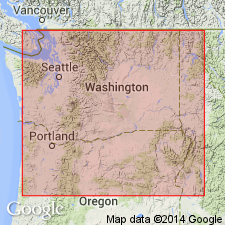
- Usage in publication:
-
- basalt of Robinette Mountain*
- Modifications:
-
- Named
- AAPG geologic province:
-
- Eastern Columbia basin
Summary:
The basalt of Robinette Mountain in Eckler Mountain Member of Wanapum Basalt (new) of Yakima basalt subgroup [informal] of Columbia River Basalt Group. A prominent cliff-former, is named for a single flow in roadcuts on Robinette Mountain (see fig. 1, loc. 43) near a powerline crossing, in NE/4 NW/4 sec. 22, T. 9 N., R. 39 E., Robinette Mountain quadrangle, Columbia County, Washington. Coarse-grained, has a distinctive coarsely diktytaxitic texture, and contains abundant olivine (commonly rimmed or replaced by iridescent iddingsite) but only rare small plagioclase phenocrysts; maximum exposed thickness is about 20 m. Has distinctive chemical composition; highest Al, lowest K and Ti content of any of flows in the Yakima. Age is middle Miocene. Has normal magnetic polarity (citing McKee and others [abs.], 1977, GSA Abs. with Prog., v. 9, no. 4, p. 463-464).
[Yakima basalt subgroup considered informal and should not be capitalized. "Subgroup" not recognized as a formal stratigraphic rank term (CSN, 1933; ACSN, 1961, 1970; NACSN, 1983, 2005, 2021). Columbia River Basalt Group adopted by the ID, OR, and WA Geol. Surveys, and the USGS.]
Source: Publication; US geologic names lexicon (USGS Bull. 1564, p. 53); Changes in stratigraphic nomenclature, 1979 (USGS Bull. 1502-A, p. A24).
For more information, please contact Nancy Stamm, Geologic Names Committee Secretary.
Asterisk (*) indicates published by U.S. Geological Survey authors.
"No current usage" (†) implies that a name has been abandoned or has fallen into disuse. Former usage and, if known, replacement name given in parentheses ( ).
Slash (/) indicates name conflicts with nomenclatural guidelines (CSN, 1933; ACSN, 1961, 1970; NACSN, 1983, 2005, 2021). May be explained within brackets ([ ]).

